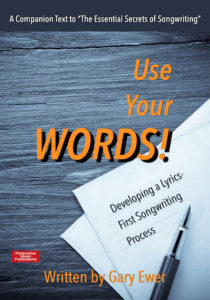Most song lyrics tell a story, but not usually in the “first this happened and then that happened” way. They largely resemble having a conversation with someone, a conversation where your side is frequently the only side that gets heard.
 “The Essential Secrets of Songwriting 10-eBook Bundle” covers every aspect of how to write great songs. Contains a Study Guide that keeps you focused on becoming a consistently better songwriter. Get a FREE E-Book when you make your purchase. Click below for details.
“The Essential Secrets of Songwriting 10-eBook Bundle” covers every aspect of how to write great songs. Contains a Study Guide that keeps you focused on becoming a consistently better songwriter. Get a FREE E-Book when you make your purchase. Click below for details.
There are lots of ways to have a conversation, but most of them can be reduced to one of two ways:
- You and your friend make comments about something that interests you both. This topic and the comments you make aren’t exactly a story, but it has (or should have) a powerful sense of relevance to you both.
- You tell an interesting story to your friend. If you were to really analyze the telling of the story, you’d see that you start by telling your friend a few things that have been happening, and then work in moments where you tell them how you feel, or at least felt at the time.
State of Mind Lyrics
It’s probably fair to say that the majority of song lyrics simply comment on a state of mind, and this is true regardless of genre or era. If you look at a classic tune like James Taylor’s “Fire and Rain”, you’ll see what I mean:
Just yesterday mornin’, they let me know you were gone
Suzanne, the plans they made put an end to you
I walked out this morning and I wrote down this song
I just can’t remember who to send it to…
As you can see, it focuses a little on a sequence of events (yesterday mornin’, they let me know you were gone… I walked out this morning and…), but it reads more like a commentary on a situation.
Even in a song from today, like Ed Sheeran’s “Bad Habits” (Ed Sheeran, Fred Gibson, Johnny McDaid), it’s not really a sequential story. There’s a bit of that, but you can tell that it’s mainly commentary:
Every time you come around, you know I can’t say no
Every time the sun goes down, I let you take control
I can feel the paradise before my world implodes
And tonight had something wonderful…
Organizing Lyrics
Getting lyrics properly organized means knowing what listeners are wanting when they pay attention to your words. In general, it’s this:
- They want to hear words that they’d expect to hear in casual conversation.
- They want to hear commentary on something that interests (or has the potential to interest) them.
- They want to share your own emotional reaction to whatever it is you’ve chosen to sing about.
The first two points are common to practically all songs. If the words you’ve chosen sound like written English — a bit stiff or formal — it’s hard to connect to words like that. And it should be a no-brainer that whatever it is you’ve written about has the potential to be interesting to most people.
That third point is probably the most important one. Listeners will definitely pick up on the emotions of the singer, and will start to experience those same emotions if the song is well-written.
And most importantly, the emotions of a song need to rise and fall. The ebb and flow of lyrical emotion acts as a kind of “pump” that has a better chance of pulling a listener in and keeping them interested.
A disorganized lyric probably comes down to point number 3 more often than not. To properly organize a song lyric, a song needs to do the following:
- Describe a circumstance, a situation, or recount a story, and start this procedure by keeping emotions minimal. This is how most verses in most songs work.
- Describe an emotional reaction to whatever the verse is about. This is the job of the song’s chorus.
- Do this at least twice (in other words, verse 1,chorus, verse2, chorus).
- Insert some optional section (bridge, instrumental solo, etc.), that moves emotion up or down, usually in the opposite direction of what the prevailing sense of emotion has been.
- Finish with either an additional verse (if the lyric needs more to sound finished), or with final chorus repeats if you need to bring things to a close.
Probably the most important part of all of this is the fluctuating emotion. A song that has a lyric that sounds disorganized often is just either too emotional all the time, or too observational with not enough emotional content.
For songs that don’t recount a specific story, do this to make sure everything sounds organized: Read your final line of lyric, and then read the line before. The second last line should lead logically to the last one. Work your way backwards through your lyric this way.
You should also do this: read your first line, and then say, “Because I said this, I then said this:” and then read your second line. Again, there should be a logic that moves your lyric forward.
An organized lyric means that you’ve written something that, even in lyrics that don’t tell a story, outlines a kind of sequential logic. It may take several times looking through your lyric, and don’t be surprised if the difference between a disorganized lyric and an organized one comes down to a change in just one or two words.
 Written by Gary Ewer. Follow on Twitter.
Written by Gary Ewer. Follow on Twitter.
 Right now when you purchase “The Essential Secrets of Songwriting” 10-eBook Bundle, you get a free copy of “Use Your Words! Developing a Lyrics-First Songwriting Process.” Immediate download!
Right now when you purchase “The Essential Secrets of Songwriting” 10-eBook Bundle, you get a free copy of “Use Your Words! Developing a Lyrics-First Songwriting Process.” Immediate download!











Nice article Gary. You always seem to touch on things I am struggling with to work out in a current song. I gained a little clarity in looking at and evaluating my most recent one from what you’ve written today. Thanks again.
Jim Reid